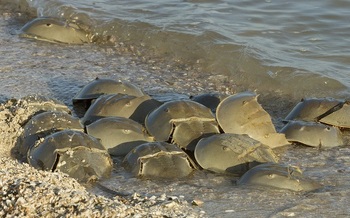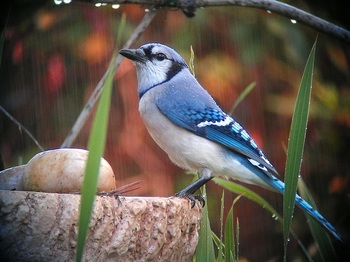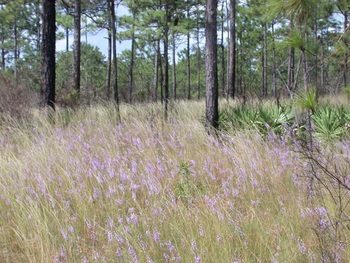 Bald Eagle by Jack Rogers
Florida has one of the densest concentrations of nesting bald eagles in the lower 48 states, with an estimated 1,500 nesting pairs. Concentrations of nesting territories are clustered around several significant lake, river, and coastal systems throughout the state. The Florida Fish and Wildlife Conservation Commission (FWC) has monitored the population of nesting bald eagles in Florida for over 40 years. Bald eagles have some biological characteristics unique to Florida. Nearly all bald eagle nests in Florida are built within 1.8 miles of water. Most clutches of eggs in Florida are laid between December and early January. Incubation lasts about 35 days. Nestlings in Florida fledge, or become able to fly from the nest, at around 11 weeks of age and remain with their parents near the nest for an additional 4-11 weeks. Most of Florida's breeding bald eagles, especially those nesting in the extreme southern peninsula, remain in the state year-round, but most subadults, or birds not quite fully mature, and non-breeding adults migrate out of Florida. Eagles migrate northward between April and August and return southward from late July through late December. Juveniles migrate northward later than older subadults. Most juveniles disperse at about 128 days of age and spend their first summer as far north as Newfoundland, with peak numbers summering around Chesapeake Bay and the coastal plain of North Carolina. Florida's bald eagles use three migration flyways - the Atlantic coast, Appalachian Mountains, and the Mississippi River valley - with equal frequency, and they use stopover sites for resting or foraging. Bald eagles are opportunistic foragers, feeding or scavenging on a wide variety of prey. Primary prey of eagles in Florida includes various fish and waterfowl species. Prey from one study in north-central Florida was composed of 78% fish (mostly catfish, especially brown bullhead), 17% birds (mainly American coot), 3% mammals, and 1% amphibians and reptiles combined.
Bald Eagle
webpage
Bald Eagle
nest locator
Bald Eagle
FAQs
 horseshoe crabs by Connie Mier FWRI
Help Document
Horseshoe Crab Nesting Beaches
Horseshoe crabs can be found in the United States from Maine
to Florida. Adult horseshoe crabs are usually found offshore, but they mate on
sandy beaches where the females deposit eggs.
Horseshoe crabs are declining in number throughout their
range due to a variety of factors, including overharvesting for the bait
industry and loss of reproductive habitat. Seawalls and other types of
shoreline development can disrupt the horseshoe crab's reproductive activities.
Shorebirds rely on horseshoe crab eggs as a primary food
source during their long migrations. The decrease in horseshoe crab abundance
has contributed to notable declines in the abundance of many shorebird species.
As a result, many states have put restrictions on horseshoe crab harvesting and
the Atlantic States Marine Fisheries Commission developed a Horseshoe Crab
Fishery Management Plan. In order to gain a better understanding of horseshoe
crab biology and mating activities, this management plan requires all Atlantic
coastal states to identify horseshoe crab nesting beaches.
The Fish and Wildlife Research Institute is asking the
public to report observations of horseshoe crab
mating activities in order to help biologists identify nesting beaches
around the state.
 Blue Jay visiting a bird bath by Andy Wraithmell
Every April communities, organizations, and individuals
nationwide celebrate gardening during National Garden Month. Gardeners know,
and research confirms, that nurturing plants is good for us: attitudes toward
health and nutrition improve, kids perform better at school, and community
spirit grows. Join the celebration and help to make America a greener,
healthier, more livable place!
Attracting wildlife to our yards by planning and planting
for their needs is simple and satisfying. If we supply adequate food, water and
shelter, we can increase the number and variety of species that visit our
properties, improving our chances of observing them more closely while
providing the habitat they need to survive.
Get started with Planting a Refuge for
Wildlife
First printed in the 1980s and now revised and updated, the
40-page “Planting a Refuge for Wildlife” booklet is designed to help a new
generation of landowners attract, enjoy and conserve wildlife. The booklet will
help you
- entice a variety of animals to your property
- evaluate your current landscape and create a
habitat plan
- select the appropriate native plants;
- design a bird, butterfly or pollinator garden;
- add nest boxes, feeding stations and water
features.

Checklist of
Florida’s birds AND butterflies
Both are now available online and in print. Visit our website for more details.
 picture by David Printiss (TNC)
Volunteers Needed!
April 15 - June 20, 2017
Volunteers
are needed to conduct avian monitoring activities on Apalachicola Bluffs and
Ravines Preserve and Torreya State Park in the Florida panhandle. The
volunteers will be assisting an FWC biologist hired to perform the post-restoration
monitoring on selected sites in support of the Multistate Sandhills Ecological
Restoration Project Phase 3. This project is a collaborative wildlife habitat
restoration effort between the states of Alabama, Florida, Georgia, Mississippi,
Louisiana and South Carolina, which is supported by a grant from the U.S. Fish
and Wildlife Service’s State Wildlife Grant Program and funding from various
conservation partners. Volunteers will
need to be able to walk through sandhill habitat and navigate using GPS to find
monitoring points, identify bird species by call as per Hamel et al.
(1996) (each point count will survey an area encircled by a 250m diameter
around the point), and work independently at times.
Contact for biologist conducting surveys: Annie Schmidt, monotropa@aol.com, 813-334-7379
Contact for FWC supervisor of project: Heather.Hitt@myfwc.com, 772-469-4267
|